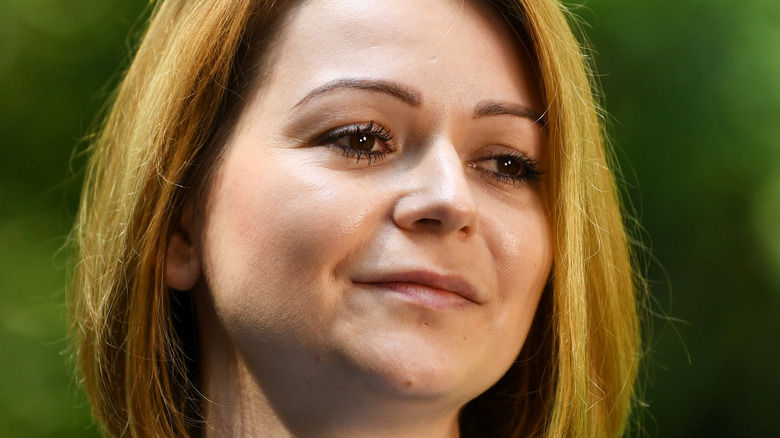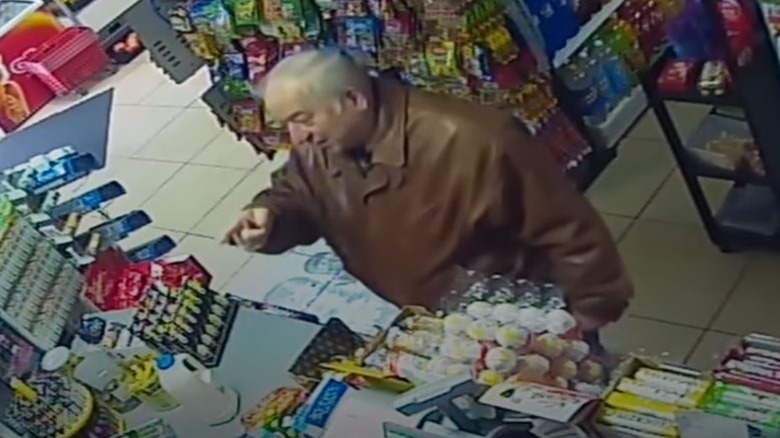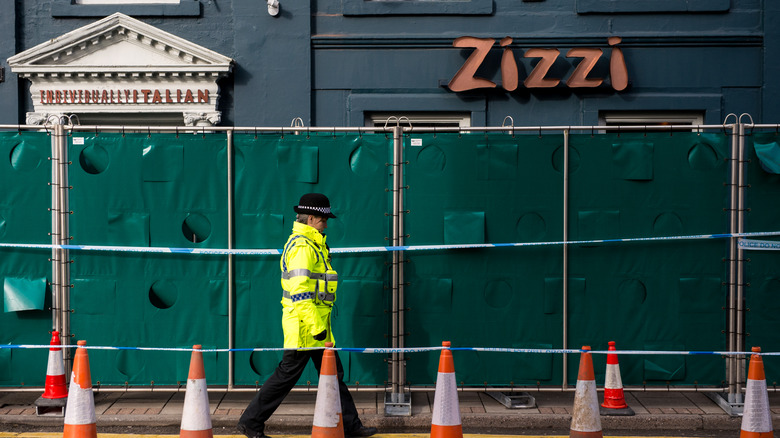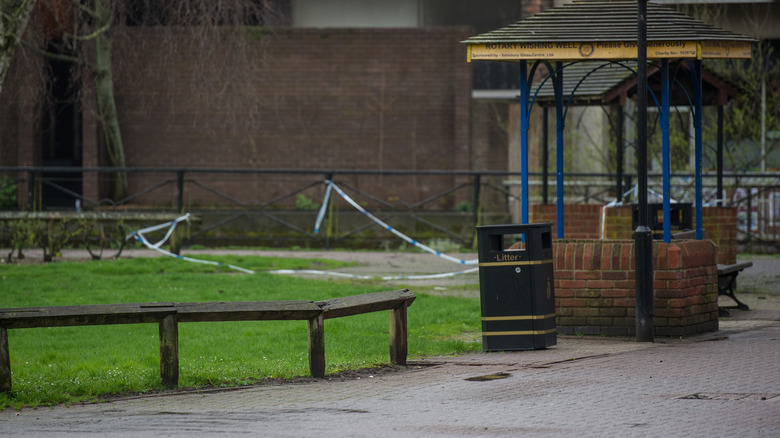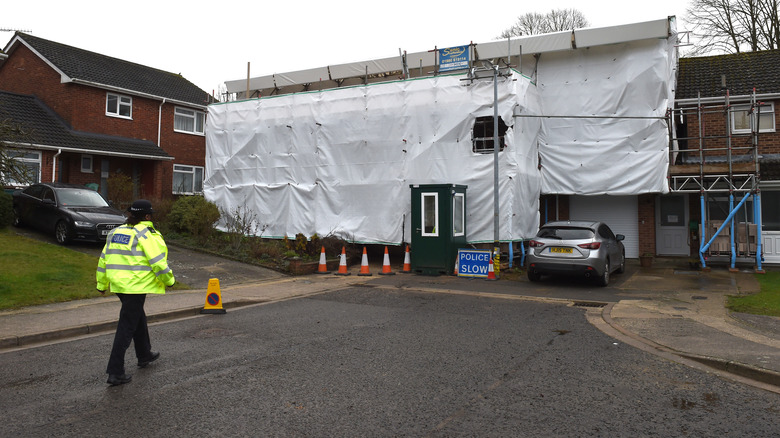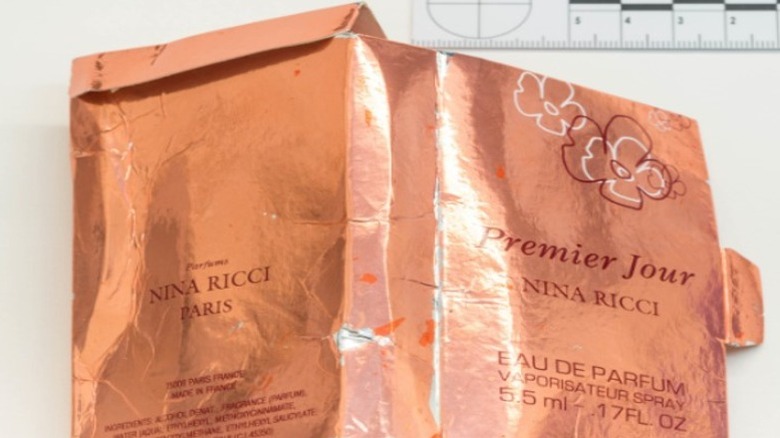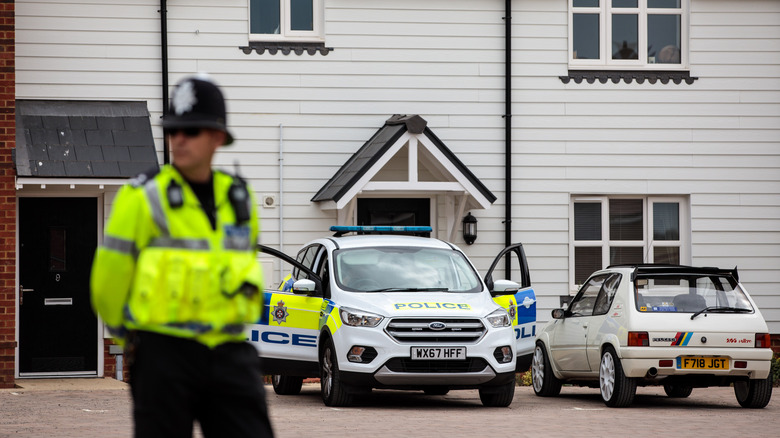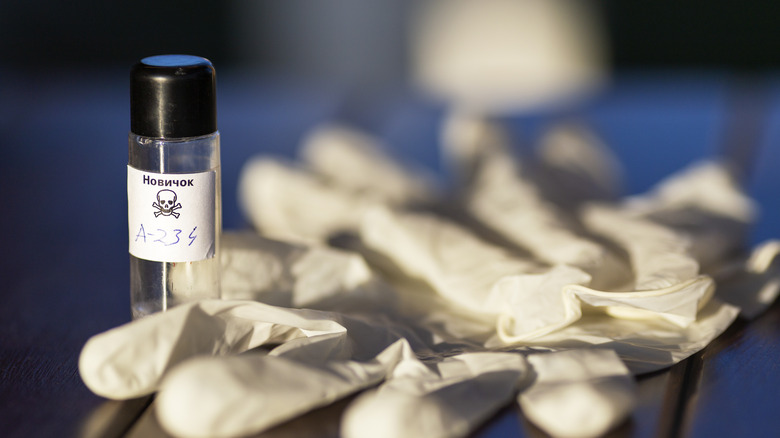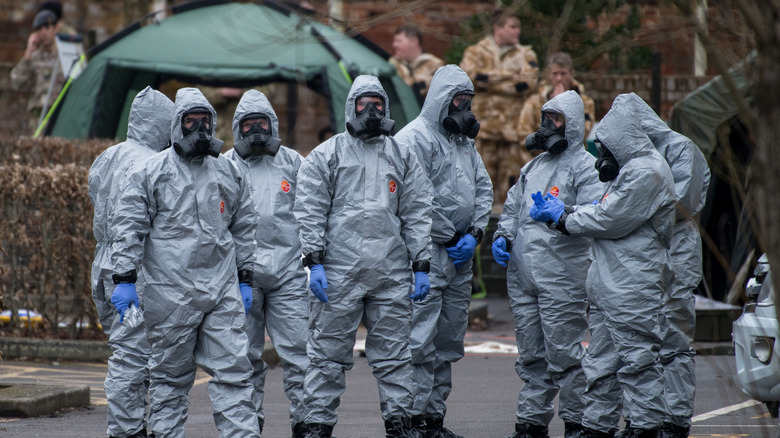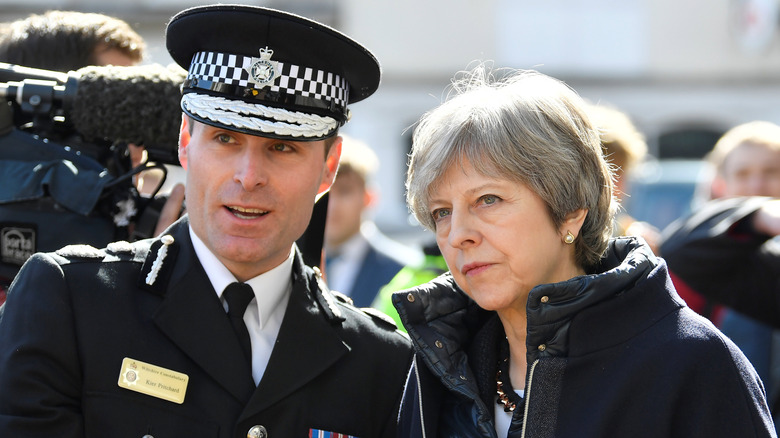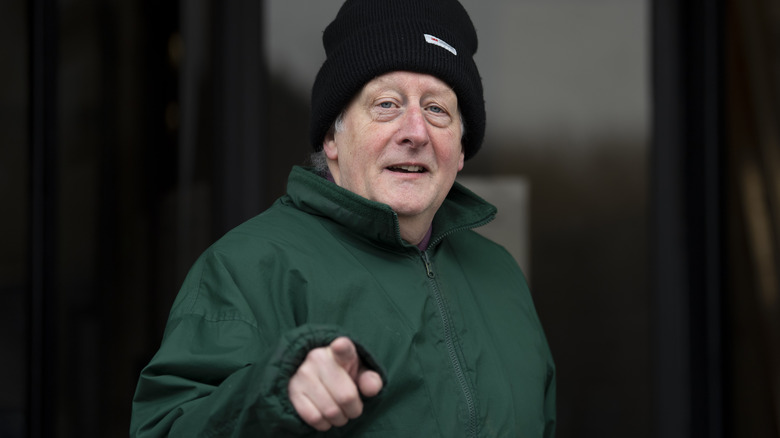The Untold Truth Of The Salisbury Poisonings
Do you know those detective stories where a seemingly simple case soon becomes far bigger and stranger than you could ever have guessed? Turns out, such strange events aren't just restricted to the realm of fiction. In 2018, one of the more peculiar mysteries of recent years emerged in Salisbury, Great Britain, when a man called Sergei Skripal and his daughter, Yulia, became targets of a particularly strange attempt on their lives (per the Independent). That sentence, however, is just the beginning of the story, which soon grew into something much larger — and impacted far more people than the Skripals.
Though the authorities have been able to build a fairly convincing timeline when it comes to the Skripals' ordeal, the case is far from closed, and it continues to have more than its share of lingering questions. As such, there's a pretty big helping of "allegedly" preceding a fair share of the events, for reasons that'll be clear in a moment. Come, let's take a look at the many strange aspects of the incident known as the Salisbury Poisonings.
Sergei Skripal had a history as a double agent
To understand what (allegedly) happened in Salisbury in March 2018, we must first look at the man at the center of the incident. According to the BBC, Sergei Skripal is no ordinary Russian expatriate. On the contrary, he used to be a high-ranking and popular Russian intelligence officer — a colonel, to be precise. What's more, while his family has denied this, he allegedly worked as a double agent on behalf of the British MI6 intelligence agency — you know, the one from the "James Bond" franchise.
Now, here's where things get really spy-like. Skripal's alleged information leaking got him a 13-year prison sentence for treason in 2006, but he only spent a fraction of that in the Russian prison system before receiving a pardon in 2010. That same year, The Guardian reported that he was one of the intelligence operatives the U.S. and Russia exchanged in Vienna, and possibly the only one who remained in Britain.
Skripal's trial had been a very high-profile one, and his reports to the United Kingdom had allegedly caused plenty of damage. In light of this, some media outlets in Russia — and, one would assume, a fair few people, too — openly considered the 13-year sentence he originally received a mere slap on the wrist, even without the early pardon and extradition deal.
Yulia Skripal arrives to Salisbury
The other initial victim of the Salisbury Poisoning, Yulia Skripal, lived in Moscow, per the BBC. She arrived in the U.K. on a flight that landed at London's Heathrow Airport on March 3, 2018, and by the next day, she was in Salisbury to visit her father, Sergei Skripal, who at that point had lived in the country for eight years (via the BBC). According to the Independent, 33-year-old Yulia and her dad may have spent the morning of March 4 visiting the graves of two dead family members, both of whom are buried in Salisbury.
In the afternoon, the Skripals drove to Salisbury's shopping district. They visited a pub called The Mill, and after that, headed to a local restaurant called Zizzi for a meal. They left the establishment around 3:35 p.m. local time, and their perfectly innocuous-seeming day together took an extremely drastic turn almost immediately after that. As it would soon turn out, they wouldn't be the only ones to suffer the effects of the poison they'd been subjected to, either.
The victims were discovered in a park
Soon after Sergei and Yulia Skripal left Zizzi, reports of two people in seriously bad condition started trickling in to the local police (via the BBC). The Skripals were found on a park bench near the restaurant they'd just dined in, and according to eyewitness reports, they were in extremely bad shape. Per a British government statement (via the United Nations), they were "slipping in and out of consciousness on a public bench," and eyewitnesses have described their symptoms — which involved foaming at the mouth and a loss of bodily control — as clearly serious, but difficult to pinpoint to any particular cause.
According to the Independent, Detective Sergeant Nick Bailey — who later felt the effects of the poison himself – was among the people who answered the call about the Skripals' situation. "I thought 'I'm a bit bored with what I'm doing, so I'll walk down to see what's going on,'" Bailey described the fateful day. "At this stage, we didn't know what had happened to them, it could have been alcohol or drug-related, or a medical emergency. We had no idea."
The Skripals were taken to hospital, and they both ultimately managed to survive the ordeal. As ABC News tells us, the bench they were found on would soon be covered by a forensic tent and eventually removed entirely.
The poison used on the Skripals affected some of the people who worked on the case
It soon became clear that Sergei and Yulia Skripal had been poisoned — and, unfortunately, they weren't the only ones. As the Independent tells us, one of the police officers who had been working on the case on the day of the poisonings, Nick Bailey, started feeling bad enough that he sought medical attention before heading home. However, his situation truly took a turn for the worse in the following night. A range of symptoms that included vomiting, terrible hallucinations, and loss of vision sent him to hospital, where he found out that he had been subjected to a nerve agent.
Bailey remained in the hospital for the next two and a half weeks, but he recovered. It later transpired that the latex glove he had worn had touched a poisoned door handle at Sergei Skripal's home, and as a result, the poison had made its way into his system. Per the BBC, another, unnamed police officer was also exposed to the poison during the investigation, though their exposure was reportedly much less severe.
The poison was a nerve agent from the Soviet era
Apart from the spy past of Sergei Skripal, the poison used on him and Yulia Skripal turned out to have connections to Russia — or rather, the Soviet Union (per the BBC). The chemical in question was a type of Soviet-era military-grade nerve agent known as Novichok. There are several types of Novichok, but in general, they disrupt the function of the nervous system, which in turn can wreak havoc with the victim's bodily functions. According to defected Russian chemist, Dr. Vil Mirzayanov, the first visible effect is severely constricted pupils. "[Then begins the] continuous convulsions and vomiting, and then a fatal outcome," he has described the effects.
According to The New York Times, this "fatal outcome" can be anything from lungs that fill with liquid to various other ways the body could fail under the nerve agent's effect. Novichok's widespread effects on the human body are considered more dangerous than those of more famous nerve agents like sarin, and it can also exist in various forms. As the Independent tells us, the Skripals had gotten their doses of poison from a door handle at Sergei's house, and by March 12, the substance had been identified as a type of Novichok.
The Amesbury poisonings were related to the incident
Sergei and Yulia Skripal might have survived the Salisbury Poisonings, but as the Independent tells us, others weren't quite as lucky. The authorities believe that the Novichok nerve agent used in the attack was the same poison that killed one person and severely injured another in the summer of 2018. On June 27, a 45-year-old man called Charlie Dowley found a bottle of what seemed to be Nina Ricci perfume in Salisbury, hung on to it, and gave it to 44-year-old Dawn Sturgess (via the BBC) three days later in Amesbury. Sturgess applied some of the supposed perfume on her wrists. Rowley accidentally spilled some on himself, too, but immediately washed it off.
The perfume, unfortunately, wasn't perfume at all, but the Novichok the authorities suspect the Skripal poisoners had used and thrown away. Sturgess and Rowley were both hospitalized on June 30, soon after coming in contact with the substance. According to the BBC, the authorities initially believed that their symptoms were drug-related, but things soon took a drastic turn and the truth unveiled. Sturgess died on July 8, and while Rowley survived, he was unconscious until July 11.
The Amesbury incident is considered to be a part of the Salisbury case, which means the Novichok used in the attack harmed a total of six victims (via the BBC). However, it's worth keeping in mind that according to the Independent, the perfume bottle contained enough Novichok to kill "thousands of people."
The suspects are alleged Russian intelligence operatives
According to the BBC, two suspects for the Salisbury Poisonings soon emerged. Shortly before the Novichok attack, two men using the identities of Ruslan Boshirov and Alexander Petrov entered the country. They were in Salisbury on March 4 — the day of the poisoning — and boarded a plane back to Russia that same evening. There's CCTV footage of them moving in the vicinity of Sergei Skripal's house, too. What's more, minuscule traces of Novichok were discovered at a hotel room they'd stayed in.
Investigative outlet Bellingcat later published a pretty thorough article about Boshirov's true identity, which, according to their research, is Colonel Anatoliy Chepiga, a highly decorated Russian Spetsnaz operative and suspected officer of the Russian GRU intelligence agency. Likewise, Petrov's real identity is reportedly GRU officer Alexander Mishkin, and per the BBC, the two men have also been linked to another attempted poisoning in Bulgaria, as well as an ammunitions storage explosion in the Czech Republic.
The two men have been charged with the Salisbury Poisonings in the U.K. (per The Guardian), along with a third Russian, Sergey Fedotov, who was charged in 2021. However, Russia has denied claims of its citizens' involvement and refused extradition, and in a 2018 interview with Russia's RT network, the two men themselves stated that they were in Salisbury simply to sightsee and check out the cathedral. British authorities think these men haven't left Russia since, and they are unlikely to do so.
The cleanup process was extremely arduous and time-consuming
The investigation of the Salisbury Poisonings has been complicated, but it's easy to forget that when someone starts spreading a military-grade nerve agent around in an unassuming city, the cleanup operation is going to be pretty heavy-duty, as well (via CNN).
Britain's Department for Environment, Food and Rural Affairs (DEFRA) was in charge of the year-long cleanup, which took place at a dozen contamination risk sites in Salisbury and Amesbury that had been significant locations in the incidents — including the Zizzi restaurant, the area the Skripals fell ill, and the home where Dawn Sturgess and Charlie Rowley were affected. Apart from civilian cleaning specialists, the operation involved nearly 200 people from the military, and per the Evening Standard, it took them a total of 13,000 hours. Perhaps understandably, the last place they got fully cleaned up was Sergei Skripal's house, which was identified as the site of a particularly high Novichok concentration early on (via the BBC).
The incident hurt Russia's relationship with lots of other countries
Despite Russia's vocal denial of having any role in the Salisbury Poisonings, the U.K. wasn't having any of it, and soon enough, the country expressed its displeasure by announcing the expulsion of 23 Russian diplomats (per the BBC). The British government wasn't alone in the situation, either. The U.S. joined the fray by showing the door to no less than 60 Russian diplomats, and over 20 other countries did the same in varying numbers. All in all, the Salisbury incident caused the expulsion of over 130 Russian diplomats (via The Guardian) in the immediate aftermath. All of this came after Prime Minister Theresa May had released a joint statement from the U.K., France, Germany, and the U.S. on March 15, less than two weeks after the attack. The statement made it clear that the countries deemed Russia the likely culprit of the poisoning — and four days later, the European Union released a statement to much the same effect.
Per The Guardian, Russia soon returned the favor by expelling foreign diplomats as well, and it seems that the story is still ongoing. As recently as April 2021, the BBC reported the Czech Republic and Russia expelled a number of each others' diplomats when two Salisbury Poisoning suspects — and suspected Russian intelligence service agents — were linked to a 2014 ammunition storage explosion in the Czech countryside.
The Skripals' current whereabouts are uncertain
So, what became of the Skripals, who almost fell victim to the Novichok attack? Yulia Skripal was hospitalized from March 4 to April 9, while 66-year-old Sergei required a longer stay and wasn't discharged until May 18 (via the Independent). However, as you might expect, they weren't able to return to their old lives just like that. Instead, both were moved to secure locations while the authorities pondered their next move.
In a 2018 interview with Reuters, Yulia spoke of her ordeal and revealed that her brush with the nerve agent left her in coma for 20 days, and she only found out what had happened after waking up. "We are so lucky to have both survived this attempted assassination. Our recovery has been slow and extremely painful," she stated. She also stated in no uncertain terms that she intended to turn down the Russian embassy's offers to help, though she did note that she wishes to return to her home country at some point.
Beyond this, news of the Skripals have been few and far between. In 2020, The Sunday Times reported that the British government had provided them with new identities and relocated them to New Zealand. However, according to the New Zealand Herald, the country's prime minister, Jacinda Ardern, was quick to dismiss the idea. "I think what I can say is don't believe every piece of speculation that you read," Ardern said.
The case inspired a dramatic Novichok hoax
In July 2018, someone started leaving bottles containing a strange substance at Wogan's Cavern, an area of Pembroke Castle in Wales (via Salisbury Journal). This happened on five separate occasions, which was concerning since it occurred so soon after the Salisbury oisonings, and some of the bottles were labeled "Novichok." According to Wales Online, the authorities didn't mess around upon learning of the situation, and the very first incident led to a full evacuation of the area and a massive reaction on virtually all hazmat-specialist fronts, up to and including nuclear.
Fortunately, no one was targeting tourists with a dangerous nerve agent, and the bottles contained a mix of brown sauce, ketchup, and water. A hidden camera eventually managed to identify the suspect, and an officer who had seen the tape happened to bump into the culprit. The hoax bottles were the brainchild of a conspiracy theorist called John Ap Evans (pictured), who was convinced that "the Novichok thing in Salisbury was a lot of lies."
Ap Evans received a prison sentence of 21 months (suspended for two years) as well as 200 hours of community service. He was also ordered to reimburse the castle for losses suffered during the forced closure his hoax caused. On top of that, he got an earful from the judge. "In many ways you are a sad, pathetic individual who wanted to bring some excitement to your life by embarking on this escapade," the judge told Ap Evans.
